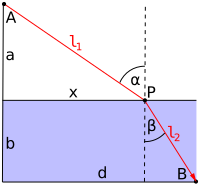Least Time Principle

The least time principle is a special rule that light follows when it travels from one place to another. You see, light is a very smart traveler and it always takes the quickest path from point A to point B. Let me explain how this works using a fun example.
Imagine you are at a park and you want to go from one end of the park to the other. There are different paths you can take, but you want to choose the fastest one because you are in a hurry. You look ahead and see that there is a big pond in the middle of the park. What do you do?
Well, one option is to walk all the way around the pond to get to the other side. But that would take a lot more time and you might start to feel tired. Another option is to take a shortcut by walking straight across the pond. But that would be a bad idea because you would get wet and probably ruin your clothes.
So, what would be the quickest path to take? It turns out, you can be really clever and choose the path that gives you the least time to reach the other side of the park. You do this by walking alongside the pond, just close enough that you don't get wet but still get to the other side quickly.
Now, how does this relate to light? Well, light also wants to get from one place to another in the least amount of time, just like you want to get to the other side of the park quickly. But instead of walking, light travels as waves. These waves can go through different materials like air, water, or glass.
When light travels from one material to another, like from air to water, it can change direction a little bit. This change in direction is called refraction. And just like you found the clever path alongside the pond, light also takes the clever path that gives it the least amount of time to get from point A to point B.
This means that when light goes from air into water, it bends slightly towards the vertical direction. It does this because the water slows down the light waves, and by bending a bit, the light can reach its destination faster. It's like taking a shortcut without getting wet!
The least time principle helps us understand how light behaves when it travels through different materials. It explains why light bends when it goes from one material to another and why we see things in a certain way. Scientists have studied this principle for a long time, and it has helped us develop things like glasses, lenses, and even fiber optic cables that carry light signals.
So, just like you try to find the quickest path to get from one place to another, light also looks for the shortest time to reach its destination. It's a very smart traveler!
Imagine you are at a park and you want to go from one end of the park to the other. There are different paths you can take, but you want to choose the fastest one because you are in a hurry. You look ahead and see that there is a big pond in the middle of the park. What do you do?
Well, one option is to walk all the way around the pond to get to the other side. But that would take a lot more time and you might start to feel tired. Another option is to take a shortcut by walking straight across the pond. But that would be a bad idea because you would get wet and probably ruin your clothes.
So, what would be the quickest path to take? It turns out, you can be really clever and choose the path that gives you the least time to reach the other side of the park. You do this by walking alongside the pond, just close enough that you don't get wet but still get to the other side quickly.
Now, how does this relate to light? Well, light also wants to get from one place to another in the least amount of time, just like you want to get to the other side of the park quickly. But instead of walking, light travels as waves. These waves can go through different materials like air, water, or glass.
When light travels from one material to another, like from air to water, it can change direction a little bit. This change in direction is called refraction. And just like you found the clever path alongside the pond, light also takes the clever path that gives it the least amount of time to get from point A to point B.
This means that when light goes from air into water, it bends slightly towards the vertical direction. It does this because the water slows down the light waves, and by bending a bit, the light can reach its destination faster. It's like taking a shortcut without getting wet!
The least time principle helps us understand how light behaves when it travels through different materials. It explains why light bends when it goes from one material to another and why we see things in a certain way. Scientists have studied this principle for a long time, and it has helped us develop things like glasses, lenses, and even fiber optic cables that carry light signals.
So, just like you try to find the quickest path to get from one place to another, light also looks for the shortest time to reach its destination. It's a very smart traveler!
Related topics others have asked about:
